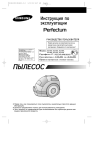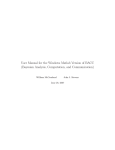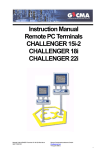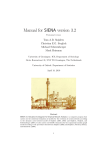Download Geostatistical Software Library and User's Guide
Transcript
GSLIB Geostatistical Software Library and User's Guide Second Edition Clayton V. Deutsch Department of Petroleum Engineering Stanford University Andre G. Journel Department of Geological and Environmental Sciences Stanford University New York Oxford OXFORD UNIVERSITY PRESS 1998 Contents I Introduction I.I 3 About the Source Code 6 II Getting Started II. 1 Geostatistical Concepts: A Review II.1.1 The Random Function Concept II. 1.2 Inference and Stationarity 11.1.3 Variogram 11.1.4 Kriging 11.1.5 Stochastic Simulation 11.2 GSLIB Conventions 11.2.1 Computer Requirements 11.2.2 Data Files 11.2.3 Grid Definition 11.2.4 Program Execution and Parameter Files 11.2.5 Machine Precision 11.3 Variogram Model Specification 11.3.1 A Straightforward 2D Example 11.3.2 A 2D Example with Zonal Anisotropy 11.4 Search Strategies 11.5 Data Sets 11.6 Problem Set One: Data Analysis III Variograms 111.1 Measures of Spatial Variability 111.2 GSLIB Variogram Programs 111.3 Regularly Spaced Data gam 111.4 Irregularly Spaced Data gamv III. 5 Variogram Maps varmap 111.6 Application Notes 111.7 Problem Set Two: Variograms vn . 9 9 11 12 13 14 18 20 20 21 22 23 24 24 29 30 32 37 40 43 43 47 50 53 55 57 62 viii CONTENTS IV Kriging IV.l Kriging with GSLIB IV.1.1 Simple Kriging IV.1.2 Ordinary Kriging IV.1.3 Kriging with a Trend Model IV.1.4 Kriging the Trend IV. 1.5 Kriging with an External Drift IV.1.6 Factorial Kriging IV.1.7 Cokriging IV.1.8 Nonlinear Kriging IV.1.9 Indicator Kriging IV.l.10 Indicator Cokriging IV.1.11 Probability Kriging IV.l.12 Soft Kriging: The Markov-Bayes Model IV.l.13 Block Kriging IV.l.14 Cross Validation IV.2 A Straightforward 2D Kriging Program kb2d IV.3 A Flexible 3D Kriging Program kt3d IV.4 Cokriging Program cokb3d IV.5 Indicator Kriging Program ik3d IV.6 Application Notes IV.7 Problem Set Three: Kriging IV.8 Problem Set Four: Cokriging IV.9 Problem Set Five: Indicator Kriging V Simulation V.I Principles of Stochastic Simulation V.I.I Reproduction of Major Heterogeneities V.1.2 Joint Simulation of Several Variables V.1.3 The Sequential Simulation Approach V.1.4 Error Simulation V.I.5 Questions of Ergodicity V.1.6 Going Beyond a Discrete CDF V.2 Gaussian-Related Algorithms V.2.1 Normal Score Transform V.2.2 Checking for Bivariate Normality V.2.3 Sequential Gaussian Simulation V.2.4 LU Decomposition Algorithm V.2.5 The Turning Band Algorithm V.2.6 Multiple Truncations of a Gaussian Field V.3 Indicator-Based Algorithms V.3.1 Simulation of Categorical Variables V.3.2 Simulation of Continuous Variables V.4 p-Field Simulation V.5 Boolean Algorithms 63 63 64 65 66 69 70 71 73 75 76 86 87 88 92 94 95 96 100 103 106 108 115 116 119 119 122 123 • • • • 125 127 128 134 139 141 . 142 144 146 147 , . . 148 149 151 152 155 156 CONTENTS V.6 Simulated Annealing V.6.1 Simulation by Simulated Annealing V.6.2 Postprocessing with Simulated Annealing V.6.3 Iterative Simulation Techniques V.7 Gaussian Simulation Programs V.7.1 LU Simulation lusim V.7.2 Sequential Gaussian Simulation sgsim V.7.3 Multiple Truncations of a Gaussian Field gtsim . . . . V.8 Sequential Indicator Simulation Programs V.8.1 Indicator Simulation sisim V.8.2 p-Field Simulation pf sim V.9 A Boolean Simulation Program e l l i p s i m V. 10 Simulated Annealing Programs V.10.1 Simulated Annealing sasim V.10.2 An Annealing Postprocessor anneal V.ll Application Notes V.12 Problem Set Six: Simulation VI Other Useful Programs VI. 1 PostScript Display VI.1.1 Location Maps locmap VI.1.2 Gray- and Color-Scale Maps p i x e l p l t VI.1.3 Histograms and Statistics h i s t p l t VI. 1.4 Normal Probability Plots p r o b p l t VI.1.5 Q-Q and P-P plots qpplt VI.1.6 Bivariate Scatterplots and Analysis s c a t p l t VI.1.7 Smoothed Scatterplot Display b i v p l t VI.1.8 Variogram Plotting v a r g p l t VI.2 Utility Programs VI.2.1 Coordinates addcoord and rotcoord VI.2.2 Cell Declustering declus . VI.2.3 Histogram and Scattergram Smoothing VI.2.4 Random Drawing draw VI.2.5 Normal Score Transformation nscore VI.2.6 Normal Score Back Transformation b a c k t r VI.2.7 General Transformation t r a n s VI.2.8 Variogram Values from a Model vmodel VI.2.9 Gaussian Indicator Variograms bigaus VI.2.10 Library of Linear System Solvers VI.2.11 Bivariate Calibration b i c a l i b VI.2.12 Postprocessing of IK Results p o s t i k VI.2.13 Postprocessing of Simulation Results postsim . . . . ix 158 159 166 167 169 169 170 174 175 175 181 182 183 183 187 189 191 199 199 201 202 204 206 207 208 210 211 211 211 213 214 222 223 226 227 230 231 232 235 236 239 CONTENTS Appendices A Partial Solutions to Problem Sets A.I Problem Set One: Data Analysis A.2 Problem Set Two: Variograms A.3 Problem Set Three: Kriging A.4 Problem Set Four: Cokriging A.5 Problem Set Five: Indicator Kriging A.6 Problem Set Six: Simulations 241 241 253 266 271 283 296 B Software Installation B.I Installation B.2 Troubleshooting 325 325 327 C Programming Conventions C.I General C.2 Dictionary of Variable Names C.3 Reference Lists of Parameter Codes 329 329 330 336 D Alphabetical Listing of Programs 339 E List of Acronyms and Notations E.I Acronyms E.2 Common Notation 341 341 342 Bibliography 347 Index 363













